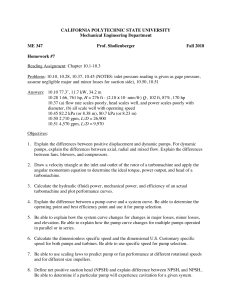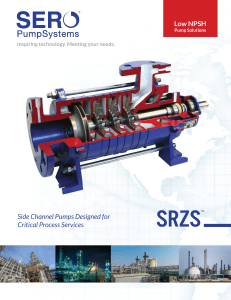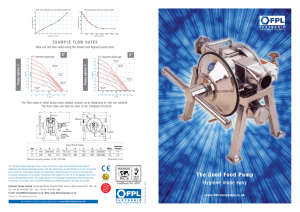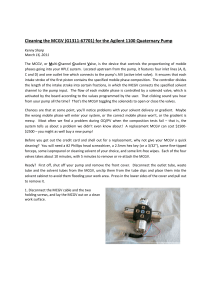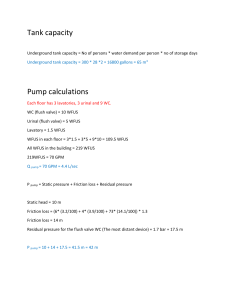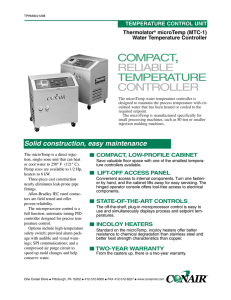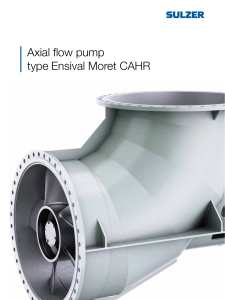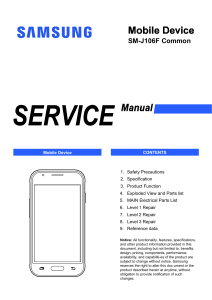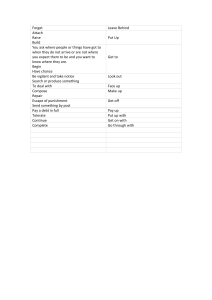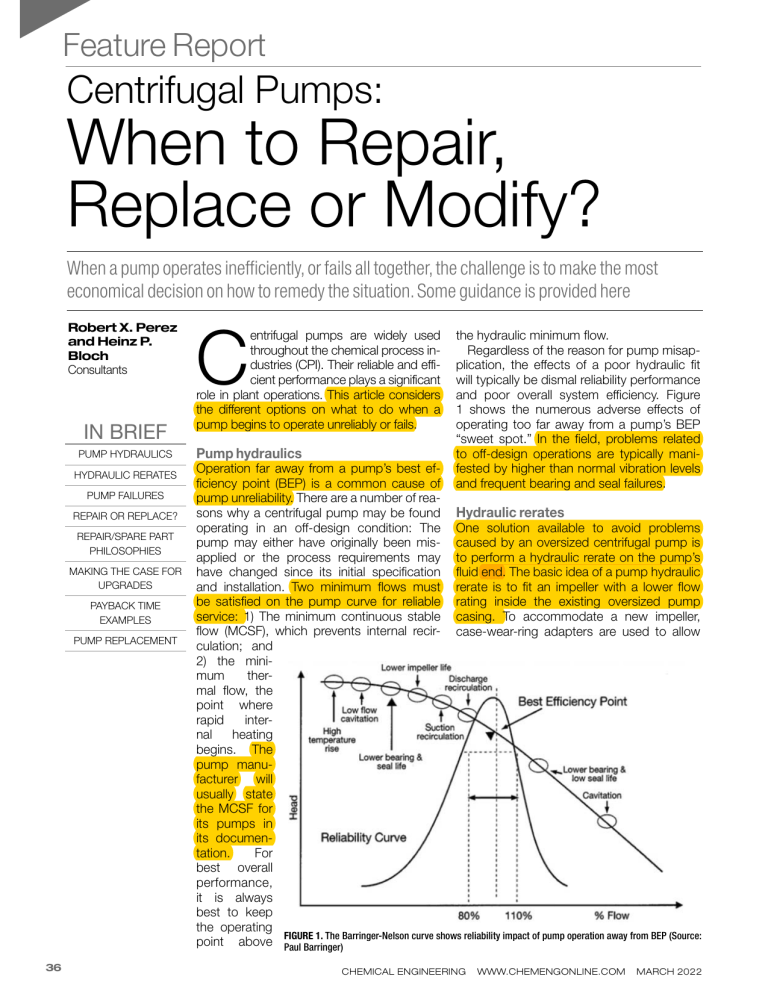
Feature Report Centrifugal Pumps: When to Repair, Replace or Modify? When a pump operates inefficiently, or fails all together, the challenge is to make the most economical decision on how to remedy the situation. Some guidance is provided here Robert X. Perez and Heinz P. Bloch Consultants IN BRIEF PUMP HYDRAULICS HYDRAULIC RERATES PUMP FAILURES REPAIR OR REPLACE? REPAIR/SPARE PART PHILOSOPHIES MAKING THE CASE FOR UPGRADES PAYBACK TIME EXAMPLES PUMP REPLACEMENT 36 C entrifugal pumps are widely used throughout the chemical process industries (CPI). Their reliable and efficient performance plays a significant role in plant operations. This article considers the different options on what to do when a pump begins to operate unreliably or fails. Pump hydraulics the hydraulic minimum flow. Regardless of the reason for pump misapplication, the effects of a poor hydraulic fit will typically be dismal reliability performance and poor overall system efficiency. Figure 1 shows the numerous adverse effects of operating too far away from a pump’s BEP “sweet spot.” In the field, problems related to off-design operations are typically manifested by higher than normal vibration levels and frequent bearing and seal failures. Operation far away from a pump’s best efficiency point (BEP) is a common cause of pump unreliability. There are a number of reasons why a centrifugal pump may be found Hydraulic rerates operating in an off-design condition: The One solution available to avoid problems pump may either have originally been mis- caused by an oversized centrifugal pump is applied or the process requirements may to perform a hydraulic rerate on the pump’s have changed since its initial specification fluid end. The basic idea of a pump hydraulic and installation. Two minimum flows must rerate is to fit an impeller with a lower flow be satisfied on the pump curve for reliable rating inside the existing oversized pump service: 1) The minimum continuous stable casing. To accommodate a new impeller, flow (MCSF), which prevents internal recir- case-wear-ring adapters are used to allow culation; and 2) the minimum thermal flow, the point where rapid internal heating begins. The pump manufacturer will usually state the MCSF for its pumps in its documentation. For best overall performance, it is always best to keep the operating FIGURE 1. The Barringer-Nelson curve shows reliability impact of pump operation away from BEP (Source: point above Paul Barringer) CHEMICAL ENGINEERING WWW.CHEMENGONLINE.COM MARCH 2022 for smaller diameter sets of casing and impeller wear rings. This would also be a fine opportunity to consider advanced perfluoralkyl (Vespel CR-6100) stationary wear parts. In addition to these modifications, volute throat area(s) must be matched to the new impeller. This is done by cutting out the original volute lips and welding in custom-designed volute lips. This simple, straightforward design approach can provide pump users a cost-effective solution to chronic failures caused by hydraulic instabilities. Performing a hydraulic rerate is the task of mechanical engineers, and outside the scope of this article. More information on how to do this and the benefits can be found in Ref. 1. We now focus on the decisionmaking process for handling a pump failure. Pump failures When a centrifugal pump fails, there are several possible paths forward that a processing facility may consider. The following options are possible: • Repair the existing pump (Figure 2) at an outside shop or in-house using replacement parts from stores • Replace it with a rebuilt pump (in kind) kept in stores • Replace it with an identical pump kept in stores or purchased from a distributor or manufacturer • Repair it with key upgraded mechanical component(s) to improve mechanical reliability • Perform a hydraulic rerate using the existing pump casing to improve the hydraulic fit (as briefly described above) • Replace existing pump with a completely different model pump that better fits the service It is important that all centrifugal-pump maintenance decisions be economically justified, meaning that the benefits derived from the repair, replacement or modification must be of greater value than the base cost. For maintenance events, such as repairs, the value added by the repair should exceed the cost of the repair. For major modifications, economic criteria, such as the investor rate of return (IRR) and net present value, should be used to objectively evaluate the benefits of the initial investment. The benefits of modifications and replacements are typically increased reliability, an improvement in efficiency, or both. A faithful economic justification requires that the user understands all the benefits derived by the modification along with all the associated modification costs. To decide which path forward makes the most economic sense, the reliability professional first needs to know the following: 1. What is the length of time since the last repair or the current mean time between failures (MTBF) metric? Best-of-class pumps easily reach MTBF between six to ten years. Pumps with MTBF of less than two years should be considered completely unacceptable. Therefore, pumps providing MTBF performance For details visit adlinks.chemengonline.com/82579-13 CHEMICAL ENGINEERING WWW.CHEMENGONLINE.COM MARCH 2022 37 greater than six years should continue to be repaired as usual and pumps providing MTBF performance less than two years should be scrutinized for improvement opportunities. Pumps with MTBF between two and six years should be reviewed on a case-by-case basis. 2. What is (are) the root cause(s) of the most recent failure? The pump owners must understand why their pump is failing before an upgrade or replacement pump can be evaluated. The most effective modifications are those that address the root cause of past failures. 3. How is the pump performing and how close to BEP is it operating? 4. What is the cost to restore the pump back to the manufacturer’s specifications? 5. What is the value of process downtime related to an unplanned pump failure? 6. What is the cost of an in-kind replacement pump and its delivery time. 7. What is the cost to keep a replacement pump in stores? 8. What is the cost of design improvements being considered? 9. What is the total cost of a centrifugal pump hydraulic rerate being considered? 10. What is the total cost to replace an existing pump with one that has a better hydraulic fit? the economic test for deciding if a pump should be repaired or replaced can be stated as follows: If the value added by the repair is greater than the repair cost minus its salvage value, then it makes more sense to repair the pump than replace it. This can be expressed by Equation (1): (1) Where: ms = market salvage value mpr = market value of the pump after repair rva = value added to the pump by the repair rc= repair cost From this relationship, we can conclude that only repairs that produce an added value greater than the cost of repair makes economic sense. This statement assumes that the pump in question can be removed from service and repaired without an economic penalty. Here are a few examples illustrating how the value-added relationship works: Example 1. Consider repairing a 150-hp centrifugal pump with the following costs: Pump salvage value = $2,000 Post repair pump value= $20,000 Value added = $20,000 – $2,000 = $18,000 Repair or replace? A common question that comes up Repair cost = $8,000 Plugging these values into Equation when pumps fail: Which pump warrants repair and which should simply (1), we see that $18,000 > $8,000. be replaced? As described in Ref. 1, Therefore, a repair is justified in this case since the value added by the repair is greater than the repair cost. Example 2. Consider repairing a 5-hp centrifugal pump with the following costs: Pump salvage value = $500 Post repair pump value = $2,000 Value added = $2,000 – $500 = $1,500 Repair cost = $4,000 Plugging these valFIGURE 2. A mechanic inspects a centrifugal pump impeller during a repair ues into Equation (1) 38 CHEMICAL ENGINEERING we see that $1,500 < $4,000. In this case, a repair is not justified since the value added by the repair is less than the repair cost. The reader will note that the lower the replacement cost, the more likely it will make sense to replace a pump than to repair it. Some facilities set a horsepower limit to define when failed pumps are simply replaced, which simplifies the decision-making process for a repair shop. Repair/spare part philosophies Once a pump is installed, site management decides its criticality and if it makes sense to repair it or replace it when it fails. Pumps that are fully spared are considered less critical, while pumps that are unspared (nonspared) are considered more critical. There are several cases to consider, as follows: • For smaller, less critical pumps (<5 hp), which are uneconomical to repair, either keep complete pump replacements in stores or order replacement pumps from the manufacturer or distributor when required. The decision to either stock a complete spare pump or order it when required will depend on the expected delivery time. • For a fully spared pump that can be removed and repaired because the other installed spare is deemed to be reliable and capable of supplying the required flow on its own: In services with medium- to large-size pumps, it makes sense to pull the failed pump and repair it — either in the shop or off site. • For a fully spared pump that can be removed without impacting the process but takes too long to repair: This might apply to troublesome pumps that fail frequently, which may mean that time to repair may approach or exceed the time between failures. In these services, it makes sense to keep a rebuilt or new pump in stores. When needed, the replacement pump can be removed from the warehouse and installed in the field. • For when an unspared pump’s downtime must be minimized due WWW.CHEMENGONLINE.COM MARCH 2022 TABLE 1. LIKELIHOOD PROJECT WILL BE APPROVED, BASED ON THE PAYBACK PERIOD other inputs are held fixed, a Payback Period Range Comment point will eventually be reached at which additions of the input < 1 year Sure to be approved yield progressively smaller, or >1 year but <2 years Likely to be approved diminishing, increases in output. >2 years but <5 years Difficult project to sell In centrifugal pump applica>5 years Not likely to be approved tions, the pump’s reliability or process capability are usually to its potential economic impact considered the commodity of interon the plant: These pumps tend est, while various design improveto be more complex and costly, so ment options can be considered it makes sense to store a pump inputs to improve reliability or capabundle or rotating assembly in the bility to a given economic evaluation. warehouse to minimize the repair There is a limit to how many ecotime in the event of major failures. nomical improvements can be made Spare seals, bearings and couplings to any given machine. Eventually, should also be kept in stores for the nth improvement will no longer minor repairs. be economically justified. Here are An ineffective spare-parts man- some examples of common centrifuagement program can negatively af- gal pump improvements: fect pump reliability at your site. For • Upgrading mechanical seals and this reason, spare parts manage- related sealing systems in a pump ment should be an integral part of to improve reliability every pump reliability program. How- • Upgrading pump casing metalever, often spare parts management lurgy to increase useful life tends to fly below the radar and is • Installing vibration monitoring often given little thought or consider- equipment to prevent catastrophic ation. To maintain the effectiveness failures of the program, a team consisting • Rerating a pump to allow opof a rotating equipment engineer (or eration closer to its best efficiency professional), shop foreman, warepoint (BEP) flow to improve hydrauhouse specialist and a management lic stability representative should be involved in • Installing a spillback line in a all critical spare part decisions and tracking. The team should also meet pump’s discharge line to prevent regularly to discuss: 1) the status of operation below its minimum continall critical spares; 2) current spare- uous stable flow (MCSF) to prevent part stocking levels; 3) changes in internal recirculation at low-flow stocking levels; 4) decisions to dis- demand conditions The payback-period method expose of obsolete inventory; 5) addition or deletions of suppliers; 6) plained here is a simple means of stocking upgraded parts, if available, evaluating the benefits of a potential and so on. After some trial and error, upgrade to management. The payan optimal mix of spare parts will be back period is defined as the initial determined for your given centrifugal investment divided by the expected annual revenue realized by the impump population. provement. The payback period of a modification is determined by dividMaking the case for upgrades Rotating machinery professionals are ing the total installation cost of the always looking for ways to improve upgrade by the annualized benefits: the reliability or capabilities of their process pumps. However, there is always a limit to the level of improvements that are economically justified. (2) The economical limit is governed by Installation costs can include, but is the law of diminishing returns [2], not limited to, the following items: which is an economic law stating • Cost of new components and that if one input in the production of equipment a commodity is increased, while all • Demolition and installation costs CHEMICAL ENGINEERING WWW.CHEMENGONLINE.COM MARCH 2022 • Warehouse spares • Required training and modification/updating of operating procedures The annualized benefits may include the following: • Reduction in repair costs • Reduction in production losses • Increase in process throughput • Energy savings Note that annualized benefits are relative terms. To define an economic benefit, you need to have a future case and a base case. For example, if a pump is failing twice a year and costs $10,000 per repair, then the base maintenance cost is $20,000/ yr. If you expect the pump failure-rate interval to increase to once every 5 years, then the future maintenance costs are expected to be $10,000/5 or $2,000/yr. In this example, the annualized benefits of the upgrade are expected to be $18,0000 per year. The point here is you must always consider the future case and the base case in determining the annualized benefits, (3) The annualized risk, or simply risk, is defined here as the sum of all the annualized losses associated with the failure mode being analyzed. Therefore, the annualized risk is equal to the annualized maintenance costs plus the annualized process losses plus the annualized environmental fines plus the annualized demurrage costs and so on. When evaluating the economics of reliability projects, we need to know the differential between the base risk and the future risk expected from the improvement. This differential is defined as the △Risk, which is the annualized benefit, or revenue, expected to be realized from a reliability improvement project. For example, assuming a pump failure results in a $20,000 repair, a $50,000 process loss, and a $100,000 demurrage cost, then the losses experienced per seal failure is $170,000. If the pump is failing twice 39
